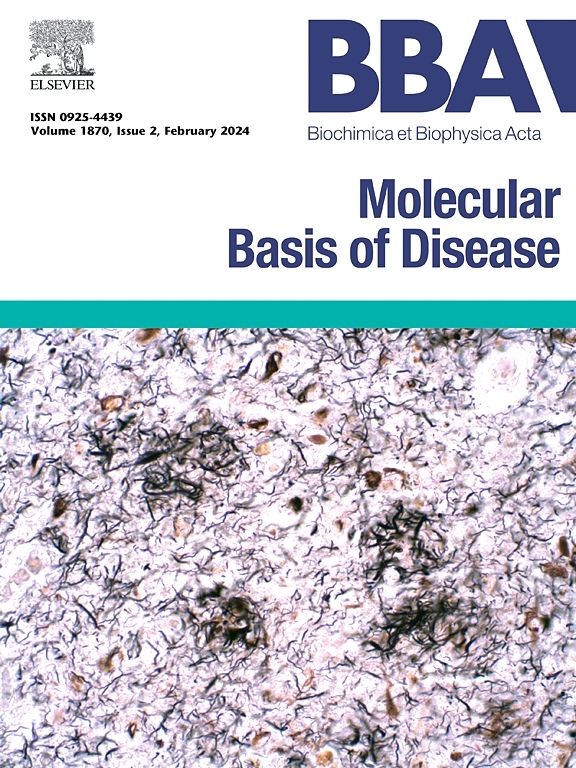Interactions between daily sleep-wake rhythms, γ-secretase, and amyloid-β peptide pathology point to complex underlying relationships
IF 4.2
2区 生物学
Q2 BIOCHEMISTRY & MOLECULAR BIOLOGY
Biochimica et biophysica acta. Molecular basis of disease
Pub Date : 2025-04-11
DOI:10.1016/j.bbadis.2025.167840
引用次数: 0
Abstract
Disrupted or insufficient sleep is a well-documented risk factor for Alzheimer's disease (AD) and related dementias. Previous studies in our lab and others have shown that chronic fragmentation of the daily sleep-wake rhythm in mice can accelerate the development of AD-related neuropathology in the brain, including increases in the levels of amyloid-β (Aβ). Although sleep is known to increase clearance of Aβ via the glymphatic system, little is known about the effect of sleep on Aβ production and the role this might play in amyloid deposition. To examine the relationship of Aβ production and its interaction with sleep and sleep dysfunction, we treated mice from an APP × PS1 mutant knock-in line (APPΔNLh/ΔNLh × PS1P264L/P264L) with an inhibitor of γ-secretase (LY-450,139; Semagacestat®) during a protocol of mild sleep fragmentation (SF). Compared to the male mice, the female mice slept less, and had more Aβ pathology. Semagacestat treatment reduced Aβ, but only in the most soluble extractable fraction. Although the female mice showed an increase in the amount of Aβ following SF, this effect was blocked by Semagacestat, an effect that was not seen in the male mice. SF also led to a significant, sex-dependent changes in the relative amounts of C-terminal fragments of the amyloid precursor protein, the immediate substrate of the γ-secretase enzyme. These findings indicate that the relationship between disruption of the daily sleep-wake rhythm and the development of AD-related pathology is complex, and may involve unappreciated interactions with biological sex. Consideration of these factors is necessary for a better understanding of AD risk, especially the elevated risk in women.
日常睡眠-觉醒节律、γ-分泌酶和淀粉样蛋白-β肽病理之间的相互作用指出了复杂的潜在关系
睡眠中断或睡眠不足是阿尔茨海默病(AD)和相关痴呆的一个有充分证据的危险因素。我们实验室和其他实验室之前的研究表明,小鼠日常睡眠-觉醒节奏的慢性碎片化可以加速ad相关大脑神经病理学的发展,包括淀粉样蛋白-β (Aβ)水平的增加。虽然已知睡眠可以通过淋巴系统增加Aβ的清除,但对睡眠对Aβ产生的影响及其在淀粉样蛋白沉积中可能发挥的作用知之甚少。为了研究Aβ的产生及其与睡眠和睡眠功能障碍的相互作用,我们用γ-分泌酶抑制剂(LY-450,139;Semagacestat®)在轻度睡眠碎片(SF)协议期间。与雄性小鼠相比,雌性小鼠睡眠更少,Aβ病理更多。Semagacestat处理降低了Aβ,但仅在最可溶性的可提取部分。虽然雌性小鼠在SF后显示出Aβ含量的增加,但这种作用被Semagacestat阻断,而在雄性小鼠中没有看到这种作用。SF还导致淀粉样前体蛋白(γ-分泌酶的直接底物)的c端片段的相对数量发生显著的性别依赖性变化。这些发现表明,日常睡眠-觉醒节律的中断与ad相关病理发展之间的关系是复杂的,可能涉及未被重视的生理性别相互作用。考虑这些因素对于更好地了解阿尔茨海默病的风险是必要的,尤其是女性的风险升高。
本文章由计算机程序翻译,如有差异,请以英文原文为准。
求助全文
约1分钟内获得全文
求助全文
来源期刊
CiteScore
12.30
自引率
0.00%
发文量
218
审稿时长
32 days
期刊介绍:
BBA Molecular Basis of Disease addresses the biochemistry and molecular genetics of disease processes and models of human disease. This journal covers aspects of aging, cancer, metabolic-, neurological-, and immunological-based disease. Manuscripts focused on using animal models to elucidate biochemical and mechanistic insight in each of these conditions, are particularly encouraged. Manuscripts should emphasize the underlying mechanisms of disease pathways and provide novel contributions to the understanding and/or treatment of these disorders. Highly descriptive and method development submissions may be declined without full review. The submission of uninvited reviews to BBA - Molecular Basis of Disease is strongly discouraged, and any such uninvited review should be accompanied by a coverletter outlining the compelling reasons why the review should be considered.

 求助内容:
求助内容: 应助结果提醒方式:
应助结果提醒方式:


